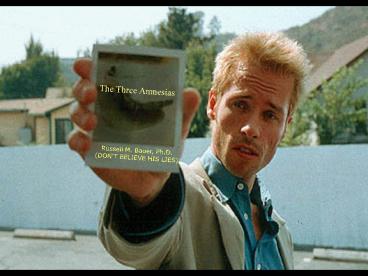Clinically Relevant Functional Neuroanatomy - PowerPoint PPT Presentation
Title:
Clinically Relevant Functional Neuroanatomy
Description:
The Three Amnesias Russell M. Bauer, Ph.D. (DON T BELIEVE HIS LIES) Core Features of Amnesia anterograde amnesia: defect in new learning retrograde amnesia ... – PowerPoint PPT presentation
Number of Views:224
Avg rating:3.0/5.0
Title: Clinically Relevant Functional Neuroanatomy
1
The Three Amnesias
Russell M. Bauer, Ph.D. (DONT BELIEVE HIS LIES)
2
Multiple Forms of Memory
3
Core Features of Amnesia
- anterograde amnesia defect in new learning
- retrograde amnesia/remote memory disturbance
defect in retrieving old memories - spared memory abilities attention span,
psychometric intelligence, and nondeclarative
forms of memory are generally spared
4
The Human Amnesic Syndrome
- Impaired new learning (anterograde amnesia),
exacerbated by increasing retention delay - Impaired recollection of events learned prior to
onset of amnesia (retrograde amnesia), often in
temporally graded fashion - Not limited to one sensory modality or type of
material - Normal IQ, attention span, nondeclarative forms
of memory
5
Clinically Relevant Dimensions of Human Memory
Performance
- Immediate-recent-remote
- Encoding-storage-retrieval
- Material, modality specificity
- Tests vs. processes
6
Encoding
- Definition process of transforming to-be
remembered in formation into memorable and
retrievable form - Encoding I bringing information-processing
capacity to bear on stimuli - Encoding II ability to use the results of E-1
mnemonically - Relevance levels-of-processing accounts of
memory (memory as by-product of information
processing) - Clinical manifestation poor immediate
(superspan) recall
7
Consolidation/Storage
- definition process of making new memories
permanent - basis anatomic and physiological changes at
cellular level hippocampal system important - when? during study-test interval
- duration hours? days? years?
- clinical symptom delayed memory ltlt immediate
memory (forgetting)
8
Retrieval
- definition process of locating, selecting, and
activating a memory representation - basis re-enactment of pattern of excitation
occurring at encoding - when? at point of test
- clinical symptom recall ltlt recognition (also
true of shallow encoding), inconsistent errors
9
(No Transcript)
10
Medial Temporal Syndromes
- Anoxic-hypoxic syndromes
- cardiac arrest
- CO poisoning
- Amnesia associated with ECT
- CNS Infections (Herpes)
- MTS and complex-partial epilepsy
(material-specific) - Early AD
11
Temporal Lobe Pathology Associated with Herpes
Simplex Encephalitis
12
The Case of Henry M (H.M.)
13
(No Transcript)
14
(No Transcript)
15
(No Transcript)
16
Bauer, Grande, Valenstein, 2003
17
Integrated Circuitry Linking Temporal,
Diencephalic, and Basal Forebrain Regions
18
Two Limbic Circuits
Anterior Thalamus
Dorsomedial Thalamus
Mamillothalamic Tract
Mammilary Bodies
Cingulate Gyrus
Orbitofrontal
Amygdalofugal pathways
Fornix
Uncus
Hippocampus
Amygdala
Lateral
Medial (Papez)
19
(No Transcript)
20
CA3
CA1
DG
subic
21
(No Transcript)
22
Bauer, Grande, Valenstein, 2003
23
Delayed Nonmatching to Sample
24
Delayed Nonmatching to Sample, multiple trials,
trial-unique objects
25
6-8 weeks postsurgery
2 years postsurgery
26
(No Transcript)
27
(No Transcript)
28
Zola-Morgan Squire, 1990
29
Bauer, Grande, Valenstein, 2003
30
Zola-Morgan Squire, 1990
31
Two Limbic Circuits and the Two-system theory of
amnesia
Anterior Thalamus
Dorsomedial Thalamus
Mamillothalamic Tract
Mammilary Bodies
Cingulate Gyrus
Orbitofrontal
Amygdalofugal pathways
Fornix
Uncus
Hippocampus
Amygdala
PRPH
Lateral
Medial (Papez)
32
Diencephalic Syndromes
- Korsakoff Syndrome associated with ETOH abuse or
malabsorption - prominent encoding deficits
- role of frontal pathology
- Vascular disease
- Thalamic trauma
33
Mamillary Body Lesions in a case of Korsakoffs
Disease
34
(No Transcript)
35
Lesion Profile in a Case of Thalamic Amnesia
36
Graff-Radford, et al, 1990
37
Two Limbic Circuits and the Two-system theory of
amnesia
Anterior Thalamus
Dorsomedial Thalamus
Mamillothalamic Tract
Mammilary Bodies
Cingulate Gyrus
Orbitofrontal
Amygdalofugal pathways
Fornix
Uncus
Hippocampus
Amygdala
Lateral
Medial (Papez)
38
Two Potential Lesion Scenarios in Diencephalic
Amnesia
39
Basal Forebrain Syndromes
- Anterior Communicating Artery (ACoA) infarctions
- prominent anterograde, variable retrograde
amnesia - prominent confabulation
- frontal extension of lesions
- Basal forebrain and cholinergic projections to
hippocampus
40
Basal Forebrain Anatomy
41
(No Transcript)
42
Two Limbic Circuits
Anterior Thalamus
Dorsomedial Thalamus
Mamillothalamic Tract
Mammilary Bodies
Cingulate Gyrus
Orbitofrontal
Amygdalofugal pathways
Fornix
Uncus
Hippocampus
Amygdala
Lateral
Medial (Papez)
43
Two Potential Lesion Scenarios in Basal Forebrain
Amnesia
44
(No Transcript)
45
Two Limbic Circuits
Anterior Thalamus
Dorsomedial Thalamus
Mamillothalamic Tract
Mammilary Bodies
Cingulate Gyrus
Orbitofrontal
Amygdalofugal pathways
Fornix
Uncus
Hippocampus
Amygdala
Lateral
Medial (Papez)
Bauer, Grande, Valenstein, 2003
46
Key Points
- Extended memory system including hippocampus,
amygdala, and basal forebrain - We (basically) understand anatomy, now we need to
understand computation - Notion of distinct subtypes of amnesia generally
less favorable now than 10 years ago - Certain structures are wired for associational
processing these structures are reciprocally
connected to cortical processors































